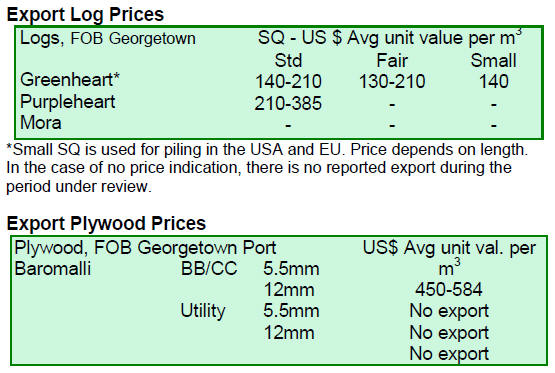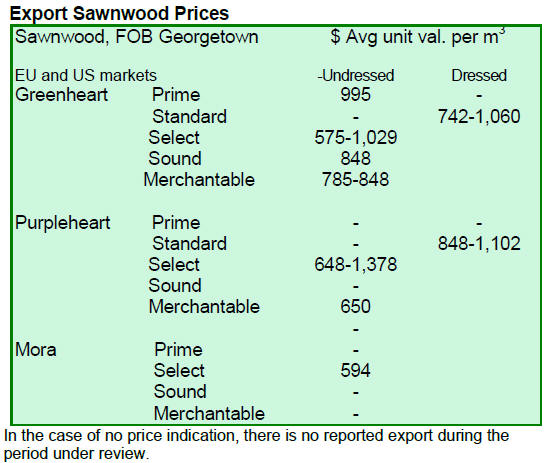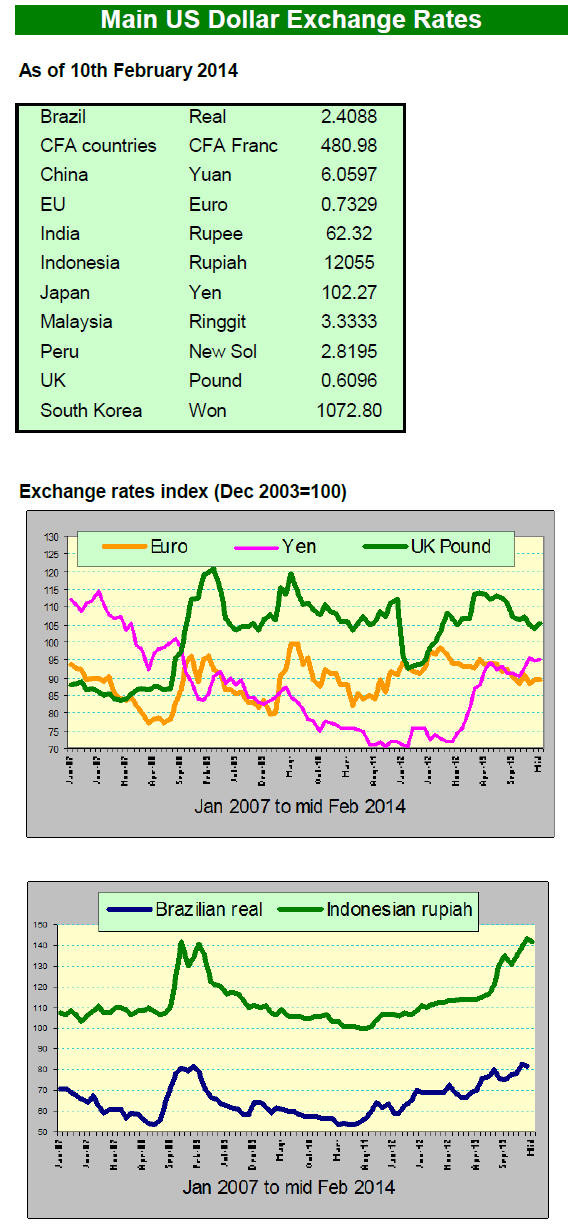2. GHANA
Civil Society calls for enforceable laws
A Civil Society Organisation, Civil Response, has said
Ghana would need to formulate laws which are
enforceable at the community level if forest conservation
programmes are to succeed .
The view is that there are significant challenges with
enforcement of laws to prohibit and control unauthorised
chainsaw milling operations in forest reserves. This, say
analysts, is driven by unsatisfied domestic demand for
timber. Reports of unauthorised harvesting are particularly
high where communities living close to forest areas need
wood products for their daily livelihood, an issue which
requires a long term solution.
Some NGOs such as Civil Response and Tropenbos (TBI)
Ghana are involved in negotiations between Ghana and the
European Union on the Voluntary Partnership Agreement
(VPA) and efforts are being directed to ensure community
issues and perspectives are considered and provided for in
the agreement.
The Programme Director at TBI, Samuel Nketiah, has said
he is confident community engagement in VPA
negotiations will help ensure the integrity of the forest.
Fuel price increases to hit timber sector
The National Petroleum Authority (NPA) increased prices
of petroleum products for the second time this year which
is having a direct impact on the logging and wood
processing industries. Petrol prices have increased 3% and
diesel prices are up 3.3%.
Prices of petroleum products are reviewed by NPA
fortnightly to reflect the prices of crude oil on the world
market and current exchange rate. According to the Ghana
Statistical Services, hikes in petroleum products prices
contribute to Ghana.s inflation which in December 2013
stood at 13.5%, up from the 13.2% in Nov.2013
Central Bank acts to stem ‘dollarisation’ of economy
To stabilise the local currency, the Bank of Ghana.s has
issued a new directive on the operation of Foreign
Exchange and Foreign Currency Accounts to stop the
.dollarisation. of the domestic economy.
The measures introduced by authorities in Ghana are
intended to streamline the operations of Foreign Exchange
Accounts (FEA) and Foreign Currency Accounts (FCA)
and to bring about clarity and transparency in their
operations on the pricing, receipts and payments for goods
and services in foreign currency.
The purpose is to ensure all transactions in the country are
conducted in Ghana cedis, which is the sole legal tender.
Failure to comply with the new legal provisions will result
in severe penalties.
However, according to the rating agency, FITCH, the
decision by Ghana's Central Bank to increase interest rates
and introduce new foreign-exchange controls is unlikely to
ease pressure on the cedi if domestic macroeconomic
imbalances are not addressed.
Interest rates climb higher
At the recent Monetary Policy Committee (MPC) meeting
the interest rate was increased to 18.0% as the bank
anticipated an uncertain short term outlook and weakening
domestic fundamentals.
These factors drove the MPC to decide for continued tight
fiscal and monetary policies and measures that would
reduce the country.s vulnerability to external shocks.
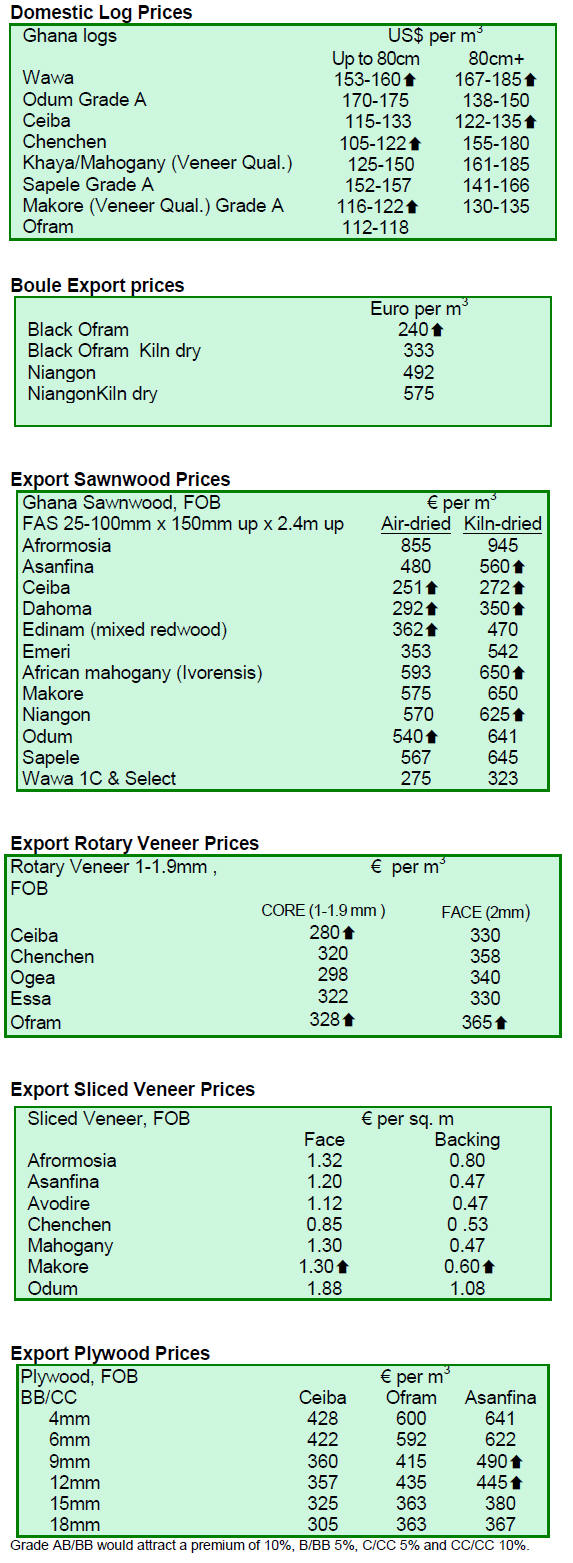
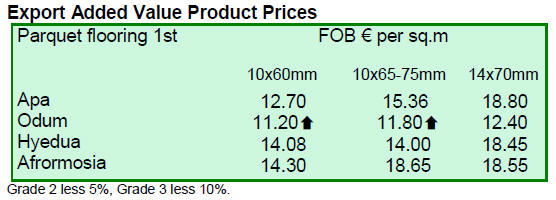
3. MALAYSIA
Top SE Asian furniture fair to open in
March
The Malaysian International Furniture Fair (MIFF) will be
held in Kuala Lumpur 4 to 8 March 2014. Since its
inception in 1995 MIFF has grown to become one of
Southeast Asia.s top furniture fairs and a global .top ten.
event.
Every March, furniture manufacturers, buyers,
international chain stores, hoteliers, architects and interior
decorators visit MIFF to conclude business take in the
latest trends and network.
Last year, business concluded as a result of MIFF totalled
US$854 million. This year the organisers expect over 500
furniture manufacturers and exporters to participate and
estimate that about 70% of participants will be Malaysian
companies, the balance coming from China, Taiwan P.o.C,
Hong Kong, Indonesia, Singapore, South Korea, USA,
UK, India, Spain and Vietnam.
On everyone.s mind at the moment is what will be the
impact of the increasing production costs being faced by
Chinese companies and asking if this will undermine the
competitiveness of Chinese made furniture.
Government urged to let newsprint anti-dumping duty
expire
The Malaysian Star newspaper has reported that the
Malaysian Newsprint Publishers Association (MNPA) is
appealing to the government not to extend the antidumping
duties on imports of newsprint paper.
A statement from MNPA urged the government to allow
the anti-dumping duties to expire as scheduled saying
“The anti-dumping duties have been imposed for the last
10 years on imports of newsprint in rolls from Canada,
Indonesia, South Korea, the Philippines and the United
States. Newsprint is a major cost component for the
newspaper business.”
The Association said that the necessary mechanisms to
ensure survival of Malaysian newsprint manufacturers are
already in place so there is no need to extend the antidumping
duties. Currently, the Government provides an
incentive in the form of an import duty waiver on
newsprint if MNPA members procure 50% of their
newsprint locally.
MNPA said the livelihood of the Malaysian newspaper
sector as a whole depends on the survival of the
newspaper industry and its ability to control cost.
“The newspaper industry employs about 12,000 workers,
about 10,000 newspaper vendors and agents, as well as
5,000 suppliers and transporters,” said the MNPA.
For the full story see
www.thestar.com.my/Business/Business-
News/2014/01/29/MNPA-says-antidumping-duties-erodemargin-
increase-cost/
Sarawak Chief Minister signals desire to step down
In Sarawak, the Chief Minister, Abdul Taib Mahmud, has
announced his desire to step down after 33 years leading
the state government. Taib said he would need to follow
protocol with his plan to step down by seeking an
audience with the governor to convey his intention.
Taib played an instrumental role in developing the timber
industry in Sarawak. While serving as the Federal minister
of primary industries, he invited FAO to undertake
resource assessment and research in the forests of Sarawak
and this laid the foundation for development of the
industry.
He also made the historic decision in May 1989 to invite
an independent mission from ITTO “to undertake a study
of sustainable forest management in Sarawak”.
Slow start for Sarawak industry after Chinese New
Year
The timber industry in Sarawak is slowly ramping up
production after the New Year holiday and reports say
plywood trading is very active.
The current plywood export prices per cubic metre have
been reported as follows:
Floor-base (11.5 mm) US$690 FOB;
Concrete formboard (3. x 6.) US$555 FOB;
For Middle East markets (9 . 18 mm) US$460 FOB;
For South Korea (8.5 . 17.5mm) US$480 . 500 C&F;
For Taiwan P.o.C (8.5 . 17.5 mm) US$455 . 460 FOB;
and for Hong Kong US$460 . 480 FOB.
2013 Plywood exports from Sarawak
Statistics published by the Sarawak Timber Association
show that for the entire year of 2013, Sarawak exported
2,576, 288 cubic meters of plywood, worth RM
4,003,850,463 (approximately US$ 1.19 billion).
Major importers were: Japan (1,429,052 cu.m; South
Korea 266,141 cu.m; Taiwan P.o.C 256,419 cu.m and
Yemen 119,084 cu.m.
4. INDONESIA
Burden of timber regulations on SMEs
highlighted
once more
A forum involving the International Centre for Trade and
Sustainable Development (ICTSD) and the Centre for
International Forestry Research (CIFOR) has highlighted
the consequences of requiring Indonesian businesses to
comply with the domestic timber legality verification
system. Now only businesses certified under Indonesia‟s
Timber Legality Assurance System (TLAS) are allowed to
export wood products.
Agus P. Djailani, a small and medium enterprises (SME)
technical assistant for the Multi Stakeholder Forestry
Programme (MSFP), said that small businesses may miss
out on the opportunity to export timber to the EU as they
lack the working capital and administrative competencies
to comply with the requirements of the scheme.
Biomass power plant for Siak
South Korean company Global Logix Co. Ltd. is set to
invest US$20 million in the construction of a wood pellet
factory and a 10,000 megawatt (MW) biomass power plant
in Siak, Riau Province.
The company has signed a memorandum of understanding
with the Siak administration for processing oil-palm fruit
bunches and kernel shells which have no commercial use.
Global Logix chairman, Myong-Ho Cho said the wood
pellet factory will produce 10,000 tons of pellets from
60,000 bunches and 20,000 tons of shells, which is the
waste generated from nearby palm plantations every
month.
The 10,000 MW biomass-fired power plant would need 3
tons of oil-palm bunches per hour. Construction of the
plant will begin in April and production is scheduled to
begin in January 2016.
South Korea has seen an increase in pellet consumption,
with 2013 figures estimated at 500,000 tons, compared to
174,000 tons in 2012.
New policy direction for major pulp and paper
corporation welcomed
WWF Indonesia has welcomed the recent forest
management policy issued by Asia Pacific Resources
International Ltd (APRIL).
The policy sets out the company‟s commitment to
supporting conservation activities and WWF-Indonesia
CEO, Efransjah, said this was a new standard for the pulp
and paper industry in Indonesia and it will contribute to
forest conservation and biodiversity, the reduction of
carbon emissions and in securing the well being of
Indonesian people.
The new policy will require a moratorium being placed on
utilising land where conservation values have not yet been
independently assessed.

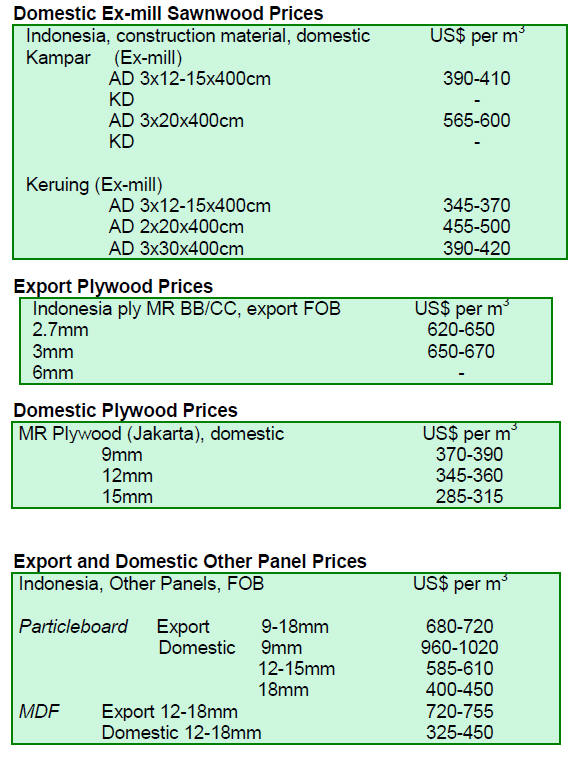
5. MYANMAR
Pace of log shipments increases
The pace of log export shipments has recently increased
but this is not because of improved demand but rather the
urgency with which buyers want to ship the logs that they
have in yards in Myanmar before the log export ban comes
into effect.
Despite the pick-up in shipments analysts still anticipate a
substantial quantity of logs will remain at log yards in
Myanmar when the log export ban comes into effect on 1
April.
Export shipments from April to the end of January 2014
are estimated to have been just over 398,000 cu.m for teak
logs and around 1,307,100 cu.m for other hardwood logs.
Debate rages over exports of teak baulks
While there is doubt in some quarters that the log ban will
really be implemented, up to now the government seems
determined to go through with its decision to ban log
exports after 1 April.
After the ban only processed wood will be allowed but
what constitutes „processed‟ in now being discussed.
Some observers say continued exports of baulk squares
(roughly hewn logs but not further manufactured) would
be an option to sustain the India market, the biggest
importer of Myanmar teak logs.
Another debate is centred on whether domestic companies
will be able to compete with mills set up by foreign
investors as they benefit from tax holidays for a certain
period. This, say local millers, will give foreign companies
a huge advantage.
Most analysts are of the view that it is unlikely that export
of baulk squares will be allowed but an announcement
from the Ministry of Environmental Conservation and
Forestry (MOECAF) is expected to clarify this.
2014 harvest plan announced
MOECAF Deputy Minister, Aye Myint Maung, has
announced that the harvest plan for the 2014-15 fiscal year
would be 108,000 cu.m of teak and 670,000 cu.m of nonteak
hardwoods.
He reiterated that no private companies would be
permitted to harvest logs and that all timber extraction will
be undertaken by the Myanma Timber Enterprise. He
further reported that after 1 April all logs would be sold by
competitive bidding for local processing only.
The deputy minister also said that, at present, there are
only around 13,560 ha. of plantations and that his
ministry is negotiating with both local and foreign
companies to increase investment in plantations.
Result of teak logs sales by open tender, Yangon 7
February 2014. These logs can be exported in log form.
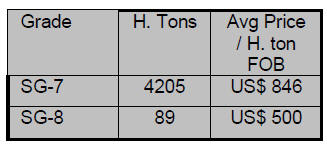
Result of hardwood logs sales by open tender 7
February
2014.
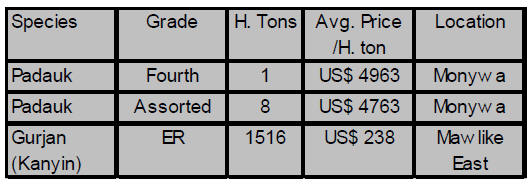
Result of handsawn timber sales by open tender on 7
February 2014.

Sales of teak logs for local processing, open
tender 7
February 2014.

January teak log tender results
The following grades and volumes were sold by Myanma
Timber Enterprise (MTE) through competitive bidding on
24 and 27 January 2014.
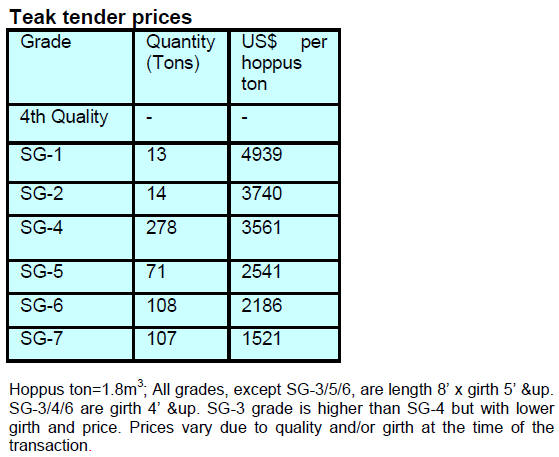
6.
INDIA
Economic prospects brighten
The outlook for the Indian economy is now looking
brighter. The shrinking of the current account deficit from
4.8 of GDP in the last fiscal year to just a little over 2% of
GDP for this year is giving hope that better days are
ahead. At the same time the rupee: US dollar exchange
rate has been stable for some time now at 61-63 to the
dollar.
Manufacturing activity recovered to a 10 month high in
January this year on account of rising domestic orders and
improving exports. India‟s manufacturing PMI rose to
51.4, the highest since March 2013, and the third straight
month of expansion.
Look East policy to stimulate economy
The government‟s „Look East‟ policy is expected to result
in increased trade with ASEAN countries and generate
private sector investment and infrastructure improvements,
all of which will strengthen the economy.
Media reports say the North East region of India is likely
to benefit from the ongoing construction of new roads and
rail links, investments partly driven by the keen interest of
British firms looking to invest in that region.
Arunachal Pradesh to industrialise its bamboo
resource
India has rich bamboo resources and more than sixty
percent is concentrated in North East India. Arunachal
Pradesh is known to harbour very diverse bamboo species.
However, this resource rich state has a long way to go to
adopt the latest bamboo processing technologies to
maximise economic benefits.
India has a strong bamboo and cane craft tradition but
does not take full advantage of the resources available.
With technical, financial and policy support from the
government through the National Bamboo Mission (NBM)
and the National Mission on Bamboo Applications
(NMBA) as well as the Arunachal Pradesh state
government, efforts are underway to industrialise the
bamboo sector.
The development of industries based on non-timber forest
products including bamboo is one focus of the industrial
policy of Arunachal Pradesh.
Bamboo development including plantation establishment,
management, harvesting and value added processing has
the potential to generate employment especially for rural
unemployed youths.
Moreover, advancing the industrial bamboo sector in the
State would produce an alternative for timber and would
expand local skills and generate income for rural
communities and the state.
The production of plywood and veneers using bamboo as
the raw material by mills within approved industrial
estates has been authorised. Further, under section 4.1 of
the Arunachal Pradesh (Control of felling and removal of
trees from non forest land) Rules, 2001; authorisation
from the Forest Department to harvest bamboo is not
required for bamboo in non reserve forest areas or
plantations.
Prices for small plantation teak logs dip
Imports of plantation teak continue to increase and there is
firm demand for good sized logs. Analysts report that
currently there is glut of small diameter logs (below 60
cms girth) as endusers are avoiding these smaller logs.
Current C & F prices for imported plantation teak at
Indian ports are shown below.
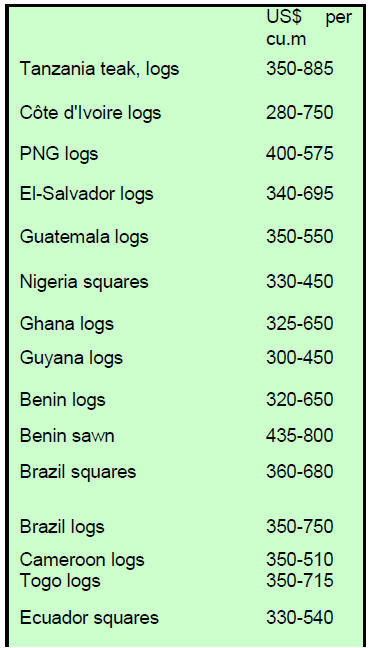
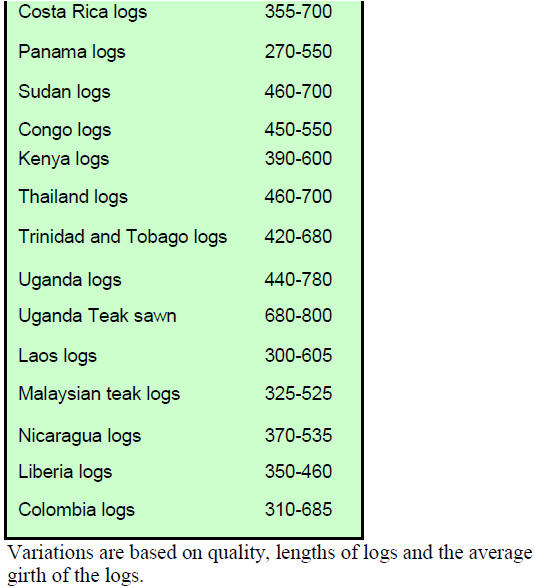
Prices for domestically sawn imported logs
Demand and supply of domestically milled imported logs
is balanced so landed costs and wholesale prices have not
changed.
Prices for air dry sawnwood per cubic Foot, ex-sawmill
are shown below.
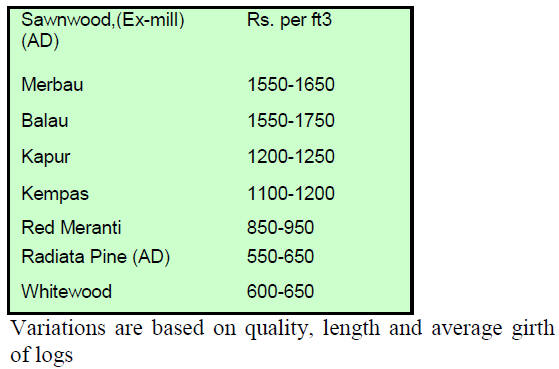
Firm international demand for teak products
International demand for teak products manufactured in
India from imported Myanmar teak continues to be good
and domestic demand has improved slightly. With the
coming log export ban being introduced in Myanmar
Indian buyers have increased the pace of log shipments out
of Yangon and Indian mills are flush with stocks of logs.
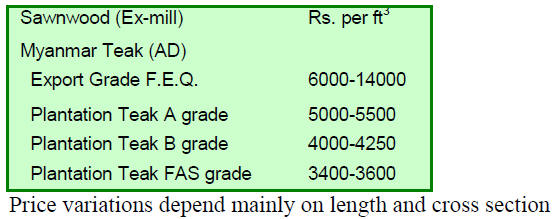
Imported sawnwood prices
Ex-warehouse prices for imported kiln dry (12% mc.)
sawnwood per cu.ft are shown below.

Plywood market depressed by slack housing sector
The domestic plywood market is still suffering from weak
demand as the housing market has not yet reacted to the
overall improvement in economic prospects.
Plywood manufacturers are trying to improve sales by
concentrating more on rural markets where demand is
better. Plywood prices remain unchanged.
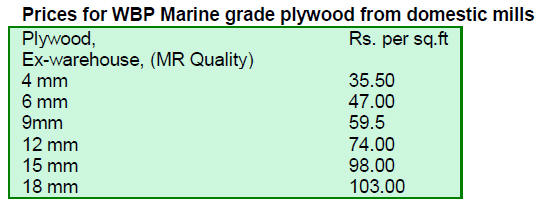
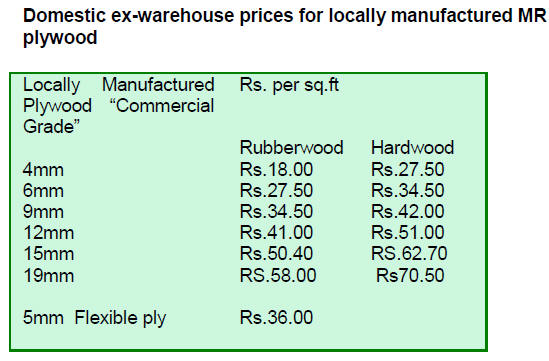
7.
BRAZIL
Forestry output could double
contribution to Mato
Grosso state growth
According to a recent report from the Program for
Sustainable Forestry Development of Mato Grosso State
(PDFS-MT) the forestry sector in the state of Mato Grosso
could significantly increase its contribution to GDP.
The report suggests it would be possible to increase the
value of output from the sector from the current R$3.3
million to over R$7 million per year. If this was achieved
then the contribution of the forestry sector to state GDP
would rise from the current 5.4% to 6.5%.
The report further says with expansion of the area of
managed natural forest, by 2030 timber production could
rise by as much as 7% for fuelwood and by over 70% for
sawnwood.
The National Forum of Forest-Based Activities (FNBF)
indicates that there are currently 214 billion ha of forest
assets in the Amazon and 28% of which it is located in the
state of Mato Grosso.
It is estimated that it may be possible to harvest up to 9
million cubic metres of wood compared to the only 3
million cubic meters harvested at the moment.
According to the Center for Timber Producers and
Exporters Industries of the State of Mato Grosso (Cipem),
the forest sector is satisfied with the outcome of PDFS-MT
study which will guide timber industry development in the
state. The PDFS-MT report is expected to promote
discussion and further evaluation of the opportunities for
increasing output from well managed forests.
Forest production increases in Mato Grosso
In 2014, the Gross Value of Production (GVP) of wood
products and fuelwood in Mato Grosso State could grow
to R$526.4 million, equivalent to 1.8% of the GVP of the
state.
Initial estimates of 2013 GVP from the Institute of
Agricultural Economics of Mato Grosso (IMEA), suggest
the GVP of the forestry sector in the state will come in at
R$501.5 million up by 5% over 2012 levels.
In determining the potential growth for 2014 it is assumed
there would be an approximate 5% increase in production
and a similar appreciation in the price of products
originating from natural forests.
In 2013, there was an 18% decline in production of logs
from natural forests but there was a slight increase in price
compared to 2012.
Sales of wood products to the international markets in
2013 earned some US$100.6 million, a 3.1% increase over
the US$ 97.5 million recorded in 2012.
Furniture exports from Bento Goncalves down in 2013
2013 furniture exports by the Bento Goncalves furniture
cluster in the state of Rio Grande do Sul dropped 7.5% to
just US$58.3 million. Despite a favorable exchange rate
for part of the year this was not enough to offset
competition for market share. In addition to the loss of
competitiveness of the Brazilian industry in general,
increases in production costs, taxes, logistics and labour
were the major causes of the fall in exports.
International markets in South America and Africa, which
account for around 80% of all exports, weakened in 2013.
In South American markets demand dropped most
significantly in Argentina, Uruguay and Venezuela.
In Africa, demand weakened in South Africa, Angola and
Mozambique but grew in Namibia. Other countries where
market demand improved in 2013 were Peru, Cuba, the
United Kingdom, Puerto Rico and Qatar.
While exporters in Bento Goncalves did not do so well in
2013, furniture exports from the State of Rio Grande do
Sul grew 2.6% in the year and this, say analysts, was due
to increased exports to Chile, Uruguay and Paraguay. In
these markets exports from Bento Goncalves fell in 2013.
Brazil's overall 2013 furniture exports fended the year
down 2.8% compared to 2012.
China the top importer of Brazilian sawnwood
Brazil.s sawnwood exports in 2013 fell 5% in value and
11% in volume year on year. In 2012, the main markets
were the Netherlands, China, France, the United States and
Vietnam, representing 13.2%, 12.5 %, 12.3 %, 11.4% and
9.2% respectively.
In 2013, the main markets remained the same as in 2012
but China became the top buyer taking 15% of all Brazil.s
sawnwood exports. Demand in the US accounted for 13%,
France 11%, the Netherlands 9% and Vietnam 7.6%.
In terms of volume, 2013 exports fell to 338,324 cubic
metres from the 379,547 cubic metres in 2012. Exporters
in Para state accounted for 35% of all sawnwood exports
followed by Mato Grosso (26%), Rondonia (14%) and
Parana (10%).
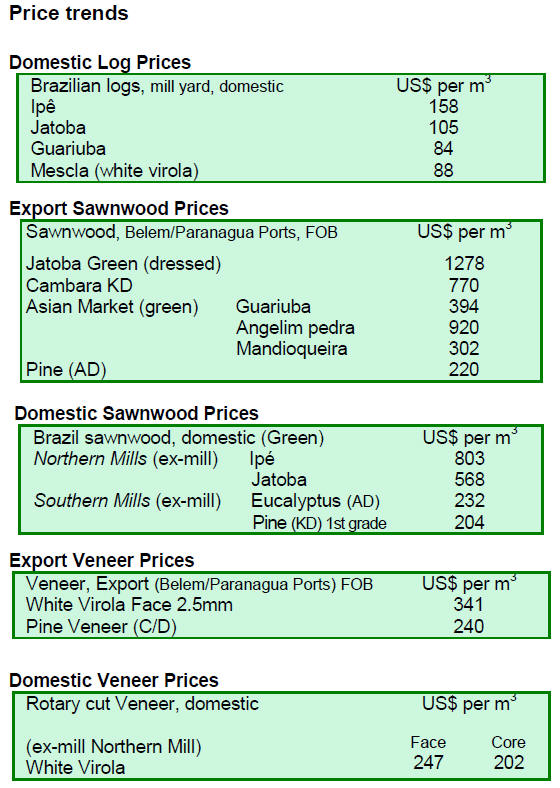
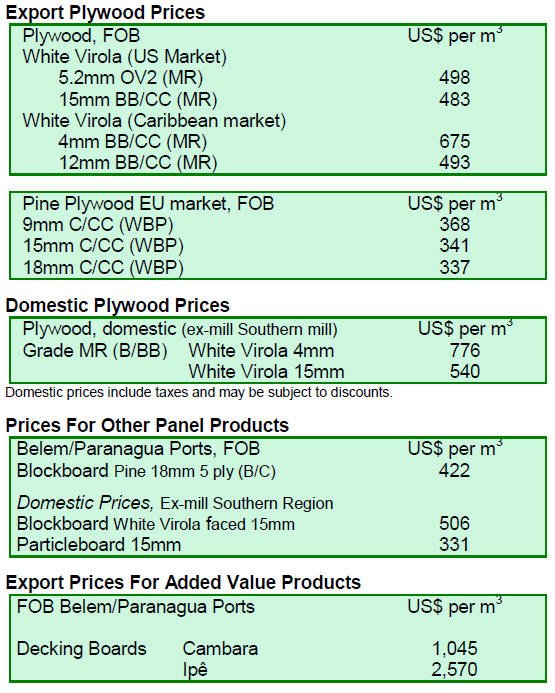
8. PERU
Peru’s 2013 timber exports did well in
weak market
Timber exports for the period January to November 2013
were worth US$ 145.7 million FOB. For the same period
in 2012 exports were almost the same at US$ 145.9
million .
Shipments in November last year, the lastest for which
data is available, were mainly to China, the U.S. and
Mexico which, together, accounted for 76 % of total value
of timber exports. The main products exported to China
were strips and friezes for parquet.
Up to November 2013, year on year demand from China
expanded almost 11%, there was a 18% improvement in
demand from buyers in the US but demand from Mexico
fell 18% year on year.
Indigenous communities propose revisiting draft
forestry regulations
The Inter-ethnic Association for the Development of
Forests (AIDESEP) has expressed concern on regulations
in the Forest Act which provide for the allocation of
concessions to investors from outside of Peru, fearing the
land rights of Amazonian indigenous peoples could be
undermined.
To allay these concerns AIDESEP is calling for the State
to execute comprehensive and independent audits of
forests investment plans submitted by large concessions
holders. The Ministry of Agriculture and Irrigation
(MINAGRI) is expected to have a final text of the relevant
regulations ready by the first half of this year.
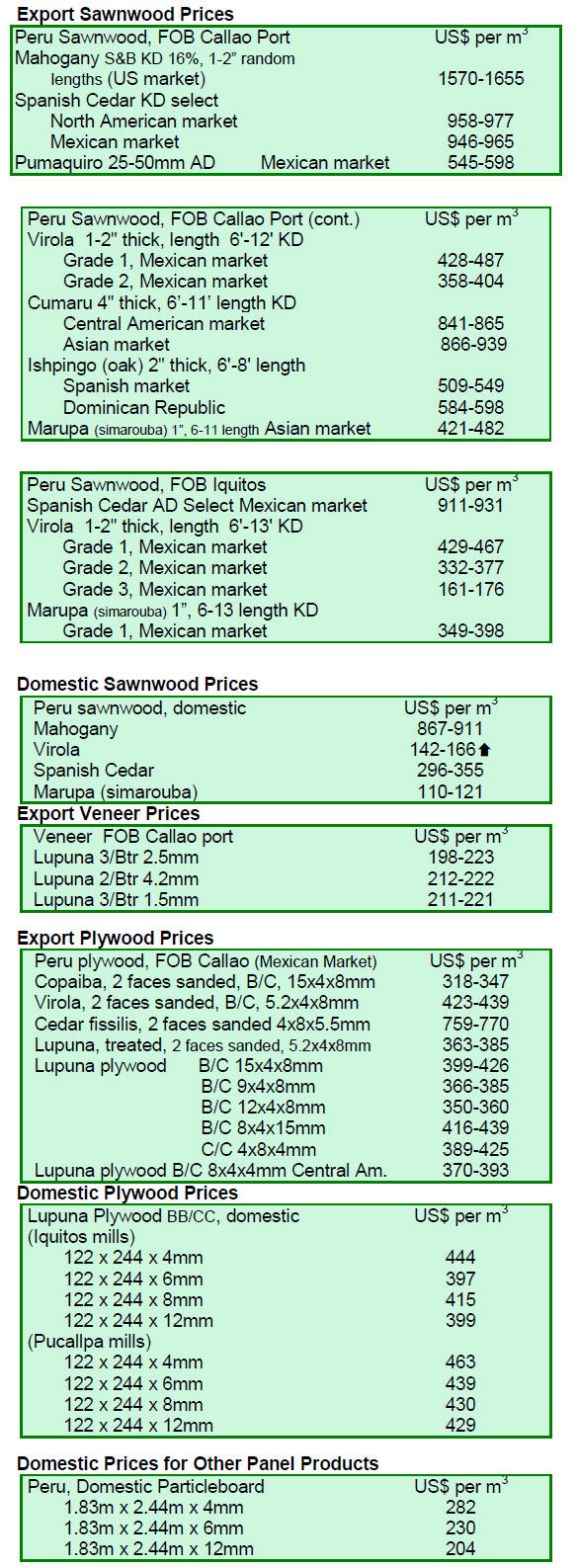
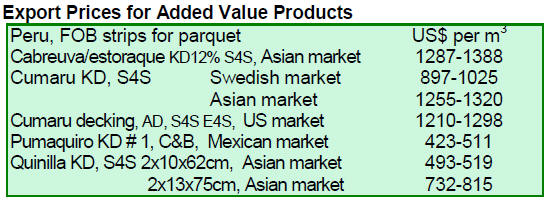
9.
GUYANA
Rising demand for logs back after lull
During the period under review exports of greenheart and
purpleheart logs resumed.
Because there had been a break in log exports, prices
changed as new orders flowed in. Greenheart prices
improved for all three log categories. Standard sawmill
quality logs were traded at FOB prices ranging from
US$140 to US$210 per cubic metre.
Likewise prices for Fair sawmill quality ranged from
US$130 to US$210 per cubic metre FOB while FOB
prices for Small category logs were US$140 per cubic
metre.
Purpleheart logs (Standard Sawmill quality) attracted
favourable prices on the export market from US$210 to
US$385 per cubic metre FOB. Buyers for markets in Asia
and the Caribbean were active and supported the trade in
purpleheart.
Additionally, wamara (Swartzia leiocalycina) logs were
exported and FOB prices held firm ranging from US$125
to US$140 per cubic metre.
Asian markets attracted by some exotic timbers
Some of the other prime species being exported in log
form included kabukalli (Goupia glabra) US$130 to
US$160 per cubic metre FOB; shibadan (Aspidosperma
spp) US$130 to US$150 per cubic metre FOB and
washiba (Tabebuia sp.) US$150 to US$170 per cubic
metre FOB. Markets in Asia were the main destinations
for these exotic timbers from Guyana.
Sawnwood exports steady
During the period under review sawnwood exports made a
positive contribution to total export earnings.
Undressed greenheart (Prime) sawnwood attracted a top
end price of US$955 per cubic metre FOB while Select
Undressed sawn greenheart prices were favourable with a
top end price ranging from US$933 to US$1,209 per cubic
metre FOB. Encouragingly, Merchantable category
Undressed sawn greenheart top end FOB prices went as
high as US$848 per cubic metre.
This durable and sustainable timber attracted diverse
markets in the Caribbean, Europe, French West Indies and
North America.
Undressed purpleheart (Select) sawnwood also
attracted a
good price on the market earning as much as US$1,378
per cubic metre FOB, on the other hand for the period
reviewed, Merchantable quality sawn purpleheart secured
only a fair FOB price of US$650 per cubic metre.
Undressed mora (Select) sawnwood prices held steady at
US$594 per cubic metre FOB for markets in the Caribbean
and New Zealand.
Growing demand for dressed sawnwood
During the period reviewed the overseas demand for
Dressed greenheart sawnwood was encouraging as this
category of sawnwood earned as much as US$1,060 per
cubic metre FOB.
Similarly, FOB prices for Dressed purpleheart held firm at
around US$1,102 per cubic metre. Markets in the
Caribbean dominated the trade in Dressed purpleheart
sawnwood.
Greenheart for marine applications
Greenheart piles attracted positive export market prices as
much as US$355 per cubic metre FOB, with Europe being
the prime market for this durable timber product which is
used for marine and wharf structures.
Guyana‟s wallapa posts earned a favourable market FOB
price of US$685 per cubic metre while wallaba splitwood
(shingles) attracted a price of US$1,091 per cubic metre
FOB in Caribbean markets.
Regional market demand supports added value
production
The Caribbean market in particular supports the
production of added value products such as craft items,
doors, indoor furniture, spindles, window frames, and
wooden utensils as well as non-timber forest products.
Exporters target new markets for washiba (Guyana ipe)
Washiba (Tabebuia sp) is known in the trade as Guyana‟s
ipe. Tabebuia is a high density timber (1,040 kg/ cu.m)
and can be found across Central and tropical South
America.
This species is also known and traded internationally as
hakia and lapacho. The Guyana Forestry Commission
(GFC) says a sustainable supply of this timber species can
be assured. Washiba has long been one of Guyana‟s export
species and can be used for a variety of end-uses where
strength, durability and appearance are important.
Between 2008 and 2013 the export price for Washiba
(Dressed) went from US$636 per cubic metre to as high as
US$2,900 per cubic metre FOB.
The increase in price was due to the significant increase in
demand for this product because of its versatile end use
applications. Washiba is especially popular for outdoor
decking particularly in the United States.
The GFC says there is potential for this timber species to
gain a stronger footing in Caribbean and other markets
where there is a need for a durable timber for use in sea
front accommodation or for decking.
Update on Guyana’s FLEGT VPA process
The Guyana Forestry Commission (GFC) has reported that
Guyana‟s engagement with the EU on a Voluntary
Partnership Agreement (VPA) is progressing and work has
continued on the various components in the agreed
Roadmap.
The National Technical Working Group meets as
scheduled and work has continued on the development of
the two projects for which Guyana has received financial
support from the Food and Agriculture Organization of the
United Nations.
The consultant for the Communication and Consultation
Strategy has met with various stakeholder groups and the
feedback garnered from this process will inform the
Communication and Consultation Strategy.
The Scoping of Impacts Study has commenced and an
initial testing of the draft Legality Definition was
conducted to ascertain the compliance level and identify
initial gaps. Both of these activities are scheduled to be
completed during the first quarter of 2014.
Funding for various aspects of the VPA is still being
explored and must be secured so that work plan for 2014
can be implemented.
Collaboration on chainsaw milling
During a second phase of the Chainsaw Milling Project in
Guyana the National Technical Working Group, NTWG
and the Project have successfully collaborated in an effort
to continue the consultation process on Guyana‟s VPA.
